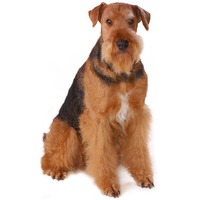
Airedale Terrier
Airedale, King of Terriers, Waterside Terrier, Bingley Terrier

Breed history:
Supposedly its ancestors are the dogs of the Dandie Dinmont and Bedlington Terrier breeds. It was first acknowledged in the Kerry County, hence the name and it is the result of some selections made in the second half of the 19th century. It was used to hunt small animals and birds, fetching both in water and on land. It was also used by the police.
Description:
This dog is medium-sized, strong, brawny and has long legs. The head is long, flat, with a smooth stop. The muzzle is the same length as the skull and has a big, black nose. The eyes are small and dark. The V-shaped ears are folded forward. It has rich and long hair on the face forming whiskers and a beard. The neck is long. The tail is set high, short, erect, without being carried on the back. The fur is soft, thick, without an inner layer and wavy. The colour varies from light blue to dark blue, darker or even black on the muzzle, head, ears, tail and legs. The pups are black at birth and will become blue at approximately 18 months old.
Personality:
It is a brave, intelligent, lively, cheerful, even noisy, alert and playful dog that can also be stubborn. Doesn't bark much and has a strong hunting instinct. It is very devoted to its master and is loving with children. It should get used with small animals (cats) not to chase them when it grows up. Other dogs may be accepted, depending on the personality of each dog. It is reserved with and suspicious of strangers.
Grooming:
This dog's fur should be occasionallyl combed. It doesn't shed. Once or twice a year the fur must be trimmed.
Living conditions:
This dog feels best outdoors in a well-fenced yard, where it can get lots of exercise with an active master with experience in raising dogs.
Training:
This dog must be trained by a person with experience that is confident and firm. The dog must be taught who the master is, because it is quite stubborn. The training must be consistent, varied, firm and done with confidence and experience. Attacking other dogs should not be tolerated, although this is an innate instinct. It likes exercise that requires physical and mental effort, the monotonous ones will make it react negatively. It loves agility exercises and flyball.
Usefulness:
It is used for hunting small wild animals, as a watchdog and as a devoted companion.

Airedale, King of Terriers, Waterside Terrier, Bingley Terrier


American Staffordshire Terrier, American Stafforshire Bull Terrier
